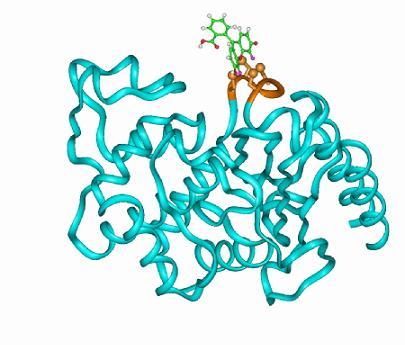The method will be applied in biomedical research, and may be used in the future in genetic engineering and gene therapy

In the picture: a computer model of the structure of the engineered protein, which includes the inserted amino acid sequence (in yellow), to which the chemical substance is linked (in green).
The living cells contain thousands of different proteins, which perform many essential functions in them. Damaged proteins, or those that do not function properly, cause diseases. The study of proteins, their structures and the way they function, led in the past to the development of drugs and treatment methods for many diseases. Thus, for example, the discovery of the involvement of the insulin protein in diabetes paved the way for the development of a treatment based on insulin injection. But despite the global research effort invested in this field, the role of many proteins is still unknown. The protein researchers carry out various genetic manipulations, which make it possible to stop the creation of a certain protein, or to greatly increase it. Such experiments show the activity and role of the protein being studied. The existing ways of turning genes off and on (responsible for the production of proteins) are complex and have various shortcomings, and do not provide a complete answer to the researchers' needs.
Prof. Moti Liskovitch and research student Oren Arster from the Department of Biological Control at the Weizmann Institute of Science, together with Dr. Miri Eisenstein, from the Department of Chemical Research Infrastructures, recently developed a unique method for installing "switches" to turn on and off, which can be inserted into any desired protein, and thus control the degree of its activity : increase it several times, and even stop it almost completely. The method provides a simple, efficient and useful research tool for researchers interested in testing the function of unknown proteins, and in the future it may have many more applications.
The switch's activation method is based on a chemical-genetic mechanism: a short sequence of several amino acids is inserted into the sequence of amino acids that make up the protein, using methods of genetic engineering. This sequence is able to bind, strongly and selectively, to a certain chemical substance. Binding of the chemical substance to the amino acid sequence affects the activity level of the engineered protein - increases or decreases it. When you stop giving the substance, or remove it from the system, the protein returns to its natural level of activity.
The first step in the method, which was recently published in the scientific journal Nature Methods, is the preparation of an array of transgenic proteins, into which the amino acid sequence is inserted in different positions. In the second step, the proteins are scanned, with the aim of identifying those that react to the administration of the chemical substance in the desired manner. Indeed, the researchers discovered that in some of the engineered proteins the chemical reduced the level of activity, while another protein responded to the chemical with increased activity. Prof. Liskovich: "The effectiveness of the method surprised us - it turns out that a very small array of engineered proteins is needed to find forms that react to the chemical substance. In biotechnology companies, it will be possible to create a much larger array of engineered proteins, and thus find a engineered protein that meets the requirements optimally."
Indeed, the method developed by the institute's scientists can be applied immediately, both for basic biochemical research on the activity of various proteins, and for pharmaceutical companies looking for proteins that are a suitable target for pharmaceutical intervention. It is an efficient, simple and powerful device that can be applied to any protein. The important advantage of the method, compared to other techniques, is the absolute and precise control over the activity of the engineered protein: its activity can be regulated in specific places, at certain times, to reach the desired level of activity, and even return to the natural level of activity, all through the administration of precise and timed doses of a simple chemical substance.
In addition, it will be possible to apply the method, in the future, in genetic medicine. It may be possible to replace damaged proteins, which cause serious diseases, with engineered proteins, and to control their level of activity precisely - by giving appropriate doses of a drug. Another possible future application is in the field of genetic engineering. The method will make it possible, for example, to produce transgenic plants in which it will be possible to precisely control the time of fruit ripening, by providing a chemical substance that increases the activity of the proteins responsible for the ripening process. In addition to this, proteins are widely used - as executors of industrial processes, as biological sensors (biosensors), and more. The ability to control the pace of these processes, increase or stop them, in an immediate and reversible way - is very valuable.

One response
Actually, it would be nice if you could provide a link to the article.